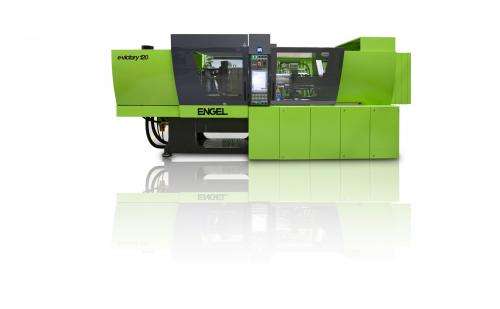Composites, foams, and coatings—innovative plastics at the international K Trade Fair

Airbags are standard equipment in automobiles today. They can save lives in emergencies, yet when no danger is present, they lie dormant beneath a cover made of plastic. These kinds of plastic components are usually injection molded. Plastic is melted, then injected into a mold for the corresponding piece and cooled until it is rigid again. Meanwhile, a new process has frequently been employed for producing the airbag covers. The process is called thermoplastic foam injection, or FIM.
The techniques offer several advantages over conventional injection molding. For one, they save up to 30 percent in material. For another, the components are less distorted, i.e. have fewer dents. In addition, designing is easier for engineers. While they have to be sure to inject the liquedfied plastic from the thicker parts of the workpiece into the thinner parts, it can also go the other way around with thermoplastic foam injection molding – i.e. from the thinner part to the thicker part of the workpiece. However, the new process also conceals a disadvantage: striations are formed on the surfaces of the plastic parts. We don't see these on most airbag covers thanks to the textured appearance that hides the irregularities. Researchers at the Fraunhofer Institute for Chemical Technology ICT in Pfinztal, Germany, now want to eliminate these striations – and so promote the use of the process for highly visible components that should be employed without a textured surface.
Injected foam without striations
Exactly what is thermoplastic foam injection molding, however? Basically, it involves common injection molding technology, in which the plastic is melted and injected into a mold before it becomes rigid. However, an FIM machine has an additional feature: it introduces a propellant into the melt. When this mixture is sprayed into the mold, the air pressure drops drastically – similar to a bottle of carbonated liquid which is shaken, then opened. The result: the plastic – researchers speak of polymers – turns to foam. The finished part is therefore not isopycnic, i.e. equally dense inside and out, but instead has a structure more like a sandwich. The interior consists of the foamed plastic, while the outer surfaces are solid and hard.
Striations appear because the hot polymer melt forms foam bubbles as it flows through the cooled tooling. These are compressed by pressure of the melted polymer against the tooling – with the irregularities becoming rigid along with the melt and remain visible at the surface of the finished piece. "We avoid formation of striations by differentially heating the tooling," says Andreas Menrath, a scientist at ICT. "The polymer remains malleable longer due to the higher tooling temperatures it comes into contact with during injection. The bubbles do not become rigid immediately, but instead the surface is pressed smooth." The researchers have already tested the equipment necessary for this and are employing it. At the moment, they are working on an additional means to prevent striations: the tooling is coated with insulation material that retains the heat within the polymer longer. The engineers are presently testing various materials and coating thicknesses. The scientists will be displaying an FIM machine at K Trade Fair and producing foam-injected frisbees right on site.
24 frisbees highlight new technologies
This is not all that visitors will get to see at the joint Fraunhofer booth. The participating Institutes will be presenting 24 different frisbees, each of which has been produced with new materials or new technologies. For example, researchers of the Fraunhofer Institute for Wood Research, Wilhelm-Klauditz-Institut WKI will be displaying a frisbee consisting of a wood and plastic composite material. This material consists of up to 60 or 70 percent wood flour, up to 20 or 35 percent plastic, and up to 5 or 10 percent additives. An additional frisbee displays laser ablation. Researchers have produced concavities by removing material at particular spots from polypropylene and polyamid substrates using a CO2 laser.
Conjoining plastic and glass
Plastic is light-weight and malleable – that is what makes it so popular. However, this malleability also results in disadvantages: the surface scratches easily. Coatings promise remedies by making the surface harder and scratch-resistant. However, since the paints and varnishes used for this are likewise polymer-based, there are limits to their hardness. Researchers of the Institute of Interfacial Process Engineering and Plasma Technology (IGVP) of the University of Stuttgart together with the Fraunhofer Institute for Interfacial Engineering and Biotechnology IGB have now developed a new type of coating: instead of plastic, it consists of glass. The scientists have thereby combined light weight and hardness for the first time. In addition, the high-rate deposition of a glass layer by plasma technology requires no more time than applying paint or varnish. The researchers will be displaying this new coating on a sample frisbee as well at K Trade Fair.
Recycled Styropor
An additional frisbee consists of recycled Styropor®. This is a first, as expanded polystyrene has always been considered unrecyclable. The reason: most Styropor is employed for thermal insulation of buildings and is therefore mixed with additives that are intended to inhibit flammability. Researchers at the Fraunhofer Institute for Process Engineering and Packaging IVV in Freising, Germany, have now developed a technology with which Styropor can indeed be recycled. The CreaSolv process produces recycled plastics whose quality is just as high as virgin plastic.
Provided by Fraunhofer-Gesellschaft





















